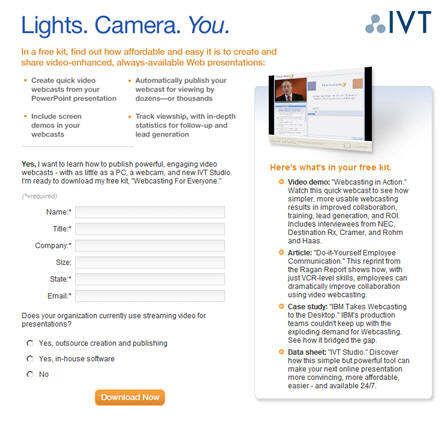Do search campaigns demand a different approach to offer strategy compared to other demand generation programs, say emails? Answer: yes. Remember, there are two fundamental truths about someone arriving at your landing page via a search ad:
1. He/she received very little information about your company in the ad (105 characters to be precise, including the URL) so it pays to consider the person uninformed and unconvinced. The reader who clicks on an email, by comparison, has received far more information and is therefore going to be much more inclined (and ready) to complete the registration process.
2. He/she could be anywhere on the buying spectrum – from initial research and education, to final, I-want-to-buy-one-of-these-today evaluation. Unless you have the time and resources to create different landing pages and offers tailored to specific buying stages (and the keywords that are a clue to those stages), your offer has to cover all bases.
We work with a lot of SaaS (Software as a Service) clients, and the inclination for those companies is to offer a free trial or download of their product. As we discussed at length in this earlier post, the problem with free trial offers is they eliminate the subset of prospects for whom a free trial is simply too much of a commitment as an initial response.
That’s doubly true for search campaigns when, as we describe above:
1. the person has received very little information to date on your product (and thus is less likely to want to try it out on the spot) and
2. a trial offer is of limited appeal to the majority of search traffic, namely those prospects only conducting cursory research and seeking solutions to a particular business problem.
 A better offer candidate for search campaigns is downloadable content – white papers, case studies, analyst reports, etc. More specifically, information “kits” tend to work well as search offers because they present a variety of information that appeals to a spectrum of buying interest:
A better offer candidate for search campaigns is downloadable content – white papers, case studies, analyst reports, etc. More specifically, information “kits” tend to work well as search offers because they present a variety of information that appeals to a spectrum of buying interest:
* an educational white paper to the prospect only just now looking for a answer to his/her business problem
* a case study to the more advanced prospect looking for real-world examples of how other companies are using the technology
* an analyst report or press review to the prospect compiling a short list of potential solutions
and so on. Plus the kit approach enables you us to present multiple content items as one singular offer, which focuses the copy and avoids distracting or confusing the reader.
Above is an example of a successful landing page we created for IVT (Interactive Video Technology), a client in Los Angeles that markets a line of corporate Webcasting solutions. The information kit features a demo and product brochure (for those more advanced prospects), an educational white paper (for prospects not yet sure whether corporate Webcasting is for them), and a case study providing more ready-to-buy prospects a strong customer reference.
If your boss (or client) is insistent upon offering a download or free trial, the best solution may be to introduce the trial as a secondary offer – i.e. not the sole reason to respond, but as part of the kit. For example, in the case of the IVT campaign, such an offer could read:
“When you download your free kit, we’ll also tell you how to qualify for a free 30-day trial of IVT Studio.”
That way, the trial is available for those who want it, but it doesn’t scare off those who don’t.
For more detailed information on offer strategy, download our free white paper: “How to Choose Your Carrot: Effective Lead Generation Offers for High-Technology Marketers.”
